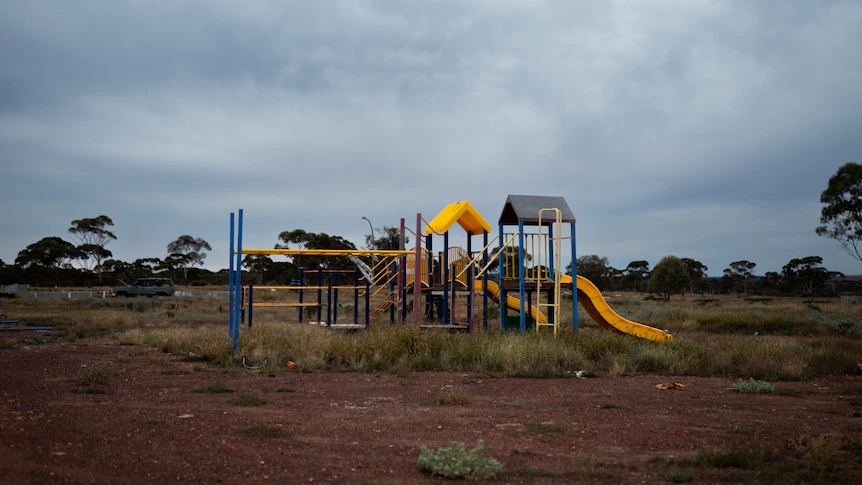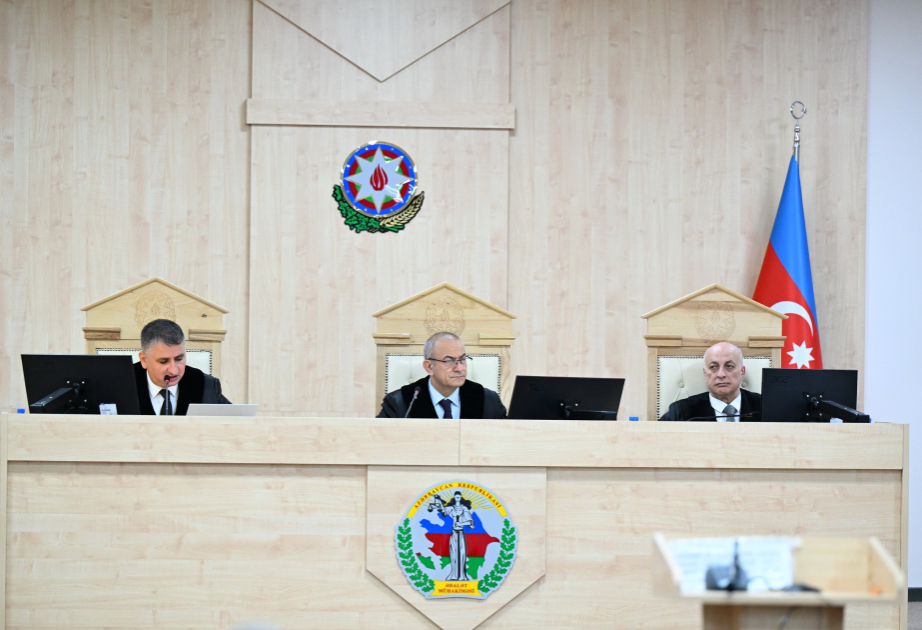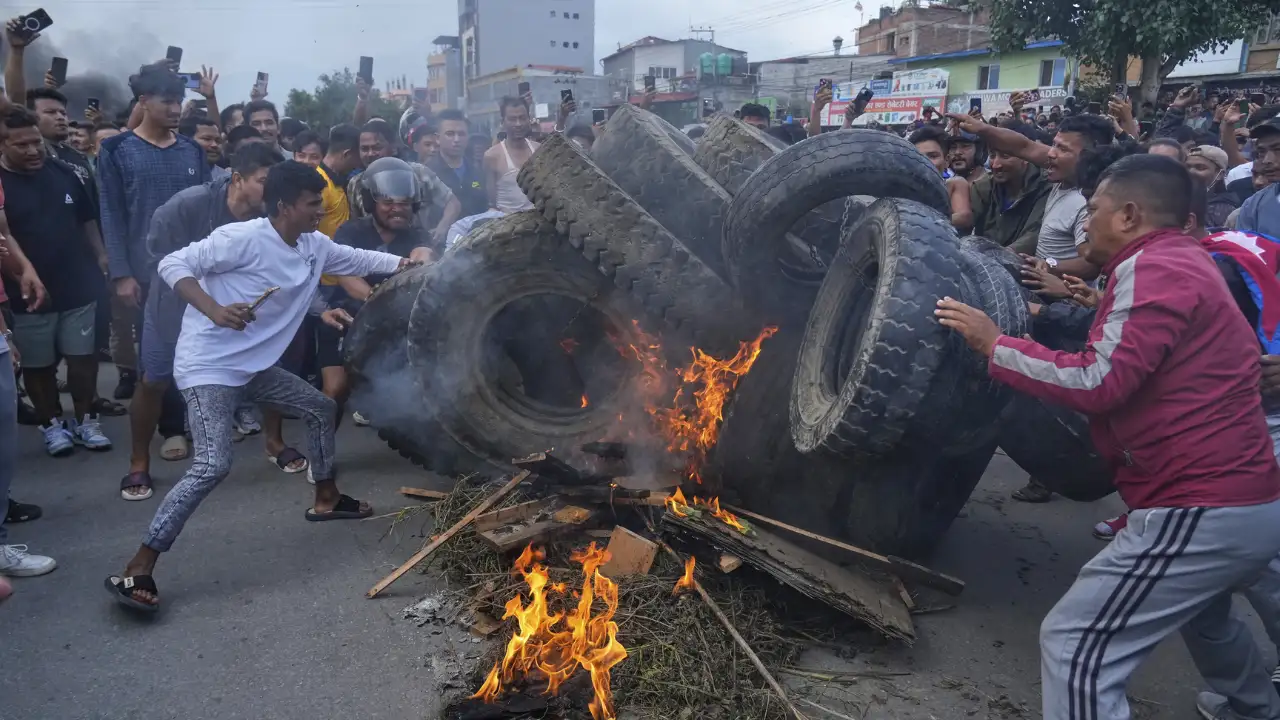By Cason Ho,Macey Turner
Copyright abc

There’s an eerie silence in Ninga Mia. It’s palpable, like a heavy fog.
The paint on the playground in the centre of the village has started to fade — the overgrown grass gives an indication of how much it’s used.
Wrecked cars, stripped to their bones, litter the landscape.
Front porch lights and fresh tyre tracks suggest some people still live here.
But it feels hollow compared to what was once a thriving place, according to those who once called Ninga Mia home.
“There was a lot of people living here — over 100 people — we had vegetables growing here, we had about 50, 60, 70 houses here,” Geoffrey Stokes says.
The Wongutha-Ngadju-Mirning Elder speaks with a sense of longing.
Ninga Mia is an Aboriginal reserve in Western Australia’s Goldfields region established in the 1980s as a government-sanctioned settlement for Aboriginal communities.
It was initially created to provide temporary housing for First Nations people, but has also served as permanent accommodation over the years.
All levels of government have invested in the village to build infrastructure and services for its community.
But a shift in policy saw Ninga Mia rapidly decay.
Most of the homes have been torn down. Many of the remaining buildings are squalid and unlivable, in part due to damage by the tenants themselves.
A WA government-commissioned audit in 2018 found no major refurbishments had been made to properties here in decades.
In 2019, then-WA Aboriginal affairs minister Ben Wyatt said Aboriginal reserves were no longer appropriate.
“I’m determined to ensure that Aboriginal people who have now for decades lived on the edge of major towns, which produce a lot of wealth and have lived in substandard conditions, move to better housing in town,” he said.
The WA Department of Housing and Works says there are 19 tenants living in seven properties at Ninga Mia, as of September 15.
It indicates the government has been successful in the first step — moving people out of the reserve — but Mr Stokes says the second step, of providing alternative housing, has fallen woefully short.
“[The government] started stripping and knocking down buildings, now we’re homeless and our people are living on the streets,” Mr Stokes says.
“We’re nothing — that’s how they treat us, like nothing, nobody, just a waste of time and space.”
The WA Department of Housing and Works is responsible for Ninga Mia’s tenants and property maintenance, but has contracted these services out to Aboriginal Community Housing Ltd (ACHL).
Repairs and maintenance are an ongoing issue, with tenants saying some requests for service have previously been ignored for months or years.
“The people pay bills … they [ACHL] take the money, but they don’t send anybody to do the work,” Mr Stokes says.
ACHL did not respond to the ABC’s questions, and directed the enquiry back to the department.
“During 2024-25, 18 individual maintenance service requests were lodged, resulting in 24 Work Orders being issued at Ninga Mia,” a department spokesperson said.
“Tenants at Ninga Mia also have access to a 24/7 service where they can self-report any maintenance needs.”
Ninga Mia is a microcosm of the cycle of displacement endured by many First Nations people.
Nuclear weapon tests in Western Australia in the 1940s and 50s displaced the Spinifex or Anangu people from the central and western desert, forcing many to move towards the large regional hub of Kalgoorlie.
But at the time, the state’s prohibition laws — which aimed to restrict Aboriginal people’s movements — barred them from entering town, which meant many struggled to find safe accommodation, and had limited access to services like healthcare.
Many ended up living in missions or reserves, similar to Ninga Mia.
City of gold
Ninga Mia sits in the shadow of the Super Pit — one of Australia’s largest open-pit gold mines — about a kilometre from the edge of the City of Kalgoorlie-Boulder.
Kalgoorlie was founded on gold in the 1890s, and its development has been linked to mining ever since.
The city’s mines have produced more than 65 million ounces of gold — that’s worth about $325 billion at today’s prices.
In a testament to the city’s historic and ongoing importance to the industry, the state’s largest annual mining conference, Diggers & Dealers, is hosted in Kalgoorlie.
But even with the gold price at record highs, the city’s riches don’t necessarily flow on to those who live in it.
Trucks and utes dusted with red dirt zoom through the city’s central boulevard.
For some people, their cars are home.
Kalgoorlie’s homelessness rate, recorded during the latest Census in 2021, was almost twice the national average.
Mayor Glenn Wilson says, amid the national housing shortage, things are worse now than he’s ever seen.
“There’s people sleeping in cars, there’s people from all walks of life … people have got jobs too and they’re actually on the streets,” Mr Wilson says.
Locals say some rough sleepers find refuge in abandoned buildings, like the train yard on the edge of town.
Australia’s housing crisis is exacerbated in regional areas, and even more so in mining cities like Kalgoorlie according to Mr Wilson, who’s lobbying the state government for help.
“Homelessness is not a city [local government] issue,” Mr Wilson says.
“We’ve seen in the metro area the old apartment building that was bought by the state government to house people.
“We’ve got some glorious old hotels that are around the city that are no longer being used — can the state government look at those options?”
Just a couple of kilometres out of town, a $65 million mining camp has been approved after one of the country’s largest gold miners, Northern Star Resources, said it had exhausted all available accommodation in town.
The camp was approved by a state government panel despite objections from the local government, and from residents who argue the town’s services are in decline.
Northern Star says the camp and its construction would ultimately lead to positive economic impacts on the community.
But Kalgoorlie’s history throws into question how much benefit local residents and the region’s First Nations people will actually receive.
Unlike most of Western Australia, native title has not been determined in large areas in and around Kalgoorlie, leaving little opportunity for mining royalties for Aboriginal communities.
Vicious cycle of homelessness
Just off the town’s main street, the sound of playful laughter drifts from one of the local churches.
Inside a fenced-off yard, children are zipping around on scooters. One child’s climbing a basketball stand. Another grins, ear to ear, with toast crumbs on his face.
Men are waiting with baskets full of laundry next to a demountable where loads of washing tumble around.
A truck with a shower inside sits in the corner of the yard. Words plastered on the side say, “for people experiencing homelessness”.
The smell of toast wafts out from a large shed, where a woman with a black cap walks around hurriedly.
One moment she has a clipboard in her hands, the next moment a child.
Tracey McCartney runs her church’s community program for people in need.
“We just provide a service for them to do their washing, have a shower, have some breakfast, charge their phones — things we don’t think of that we need, when we have a house,” she says.
“Being a hub in the Goldfields, a lot of people come from outlying communities or towns for medical reasons, or for shopping, or family, funerals, a lot of different reasons.”
Kalgoorlie, like many other regional centres around the country, is grappling with both insufficient temporary accommodation for communities that drift in and out of town, and housing for permanent residents.
“There’s definitely not enough housing. The wait list for public housing can be years,” Ms McCartney says.
“Then you have people on the streets longer, you have their health affected because, like now with the cold weather coming in hospital admissions go up because of people’s health — it’s just a vicious cycle.”
As of March, there were 458 applications for social housing in Kalgoorlie, according to the Department of Communities.
The number of applications has grown 45 per cent since March 2020.
“The state government is doing all it can to boost social housing, including working to retain ageing social housing properties and investing in alternative construction methods,” a Communities spokesperson said.
The department says it has also helped fund a range of homelessness services in Kalgoorlie including emergency accommodation and health services, and that planning is underway for wrap-around support services.
The bigger story
The City of Kalgoorlie-Boulder published a research report in April titled “Antisocial Behaviour and Transitional Aboriginal Homelessness”.
The city’s chief executive Andrew Brien said the community’s “number one issue” was the perception of antisocial behaviour due to the presence of people on the street who appear homeless.
“If you get a group of people congregating in a park, for example, the rest of the community don’t feel safe using that park,” Mr Brien says.
“It’s predominantly the people who are coming in from the lands … so they’re staying in overcrowded housing or they’re staying on the streets.
The city did not consult any First Nations stakeholders for its report, but Mr Brien says they will be included in a “think-tank” later this year.
“Not everybody who’s homeless and rough sleeping, and even possibly drinking or intoxicated, are going to be involved in antisocial behaviour,” Ms McCartney says.
“We need to look at people and see that there’s a big story behind what they’re going through, and that story is different for every person, and taking the time just to hear that story and try and walk in people’s shoes can be really valuable for us.”
‘Listen to the local’: Elder
Noongar-Gija Elder Bill Ring, who has worked for decades to improve things for First Nations people, has a simple message: “Listen”.
“For 40 years I’ve seen it, and there’s still no improvement … there’s little bits and pieces, but it hasn’t changed much,” Mr Ring says.
The former Indigenous special police officer, now a mental health worker, is potentially facing homelessness himself.
“We all drive around Kalgoorlie and look around … a blind man could see that problem,” he says.
The elder helped form the Eastern Goldfields First Nations Council in 2021, which aims to hold organisations to account on Closing the Gap targets, including homelessness.
“That’s local government, the police, other organisations that get Aboriginal funding for Closing the Gap,” Mr Ring says.
“People say they get funding for this and that program … but what do you have to show for it?”
Despite Ninga Mia’s condition, Mr Ring says its remaining residents won’t give up on their homes.
“They’re going to stay because their mothers, their forefathers, they lived out here,” Mr Ring says.
“If they want to address the homelessness, then they’ve got to look at the places where the people feel comfortable in staying.”
He’s urging all levels of government to consult with First Nations communities when addressing issues affecting them.
“Listen to the local person, the local elder, a local bloke who’s been there done that,” Mr Ring says.
“We’re ready to work, we’re ready to talk — but it’s up to them.”



